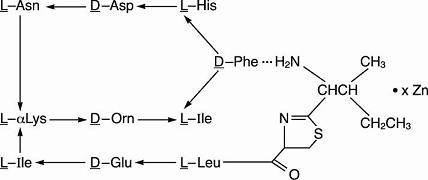Polysporin
Generic name: bacitracin zinc and polymyxin B sulfate
Dosage form: Ophthalmic Ointment,
Drug class:Ophthalmic anti-infectives
Medically reviewed by Drugs.com. Last updated on Sep 21, 2021.
On This Page
Description
Polysporin Ophthalmic Ointment (bacitracin zinc and polymyxin B sulfate ophthalmic ointment) is a sterile antimicrobial ointment for ophthalmic use. Each gram contains: bacitracin zinc equivalent to 500 bacitracin units, polymyxin B sulfate equivalent to 10,000 polymyxin B units, and white petrolatum, q.s.
Bacitracin zinc is the zinc salt of bacitracin, a mixture of related cyclic polypeptides (mainly bacitracin A) produced by the growth of an organism of the licheniformis group of Bacillus subtilis var Tracy. It has a potency of not less than 40 bacitracin units per mg. The structural formula for bacitracin A is:

Polymyxin B sulfate is the sulfate salt of polymyxin B1 and B2 which are produced by the growth of Bacillus polymyxa (Prazmowski) Migula (Fam. Bacillaceae). It has a potency of not less than 6,000 polymyxin B units per mg, calculated on an anhydrous basis. The structural formulae are:

Clinical Pharmacology
A wide range of antibacterial action is provided by the overlapping spectra of bacitracin and polymyxin B sulfate.
Bacitracin is bactericidal for a variety of gram-positive and gram-negative organisms. It interferes with bacterial cell wall synthesis by inhibition of the regeneration of phospholipid receptors involved in peptidoglycan synthesis.
Polymyxin B is bactericidal for a variety of gram-negative organisms. It increases the permeability of the bacterial cell membrane by interacting with the phospholipid components of the membrane.
Microbiology: Bacitracin zinc and polymyxin B sulfate together are considered active against the following microorganisms: Staphylococcus aureus, streptococci including Streptococcus pneumoniae, Escherichia coli, Haemophilus influenzae, Klebsiella/Enterobacter species, Neisseria species, and Pseud...



